ACC305 Second Semester: Islamic Finance Development in the Maldives
VerifiedAdded on 2023/06/03
|7
|1500
|269
Report
AI Summary
This research paper provides an in-depth analysis of the Islamic Financial System and its potential implementation in the Maldives. The paper begins with an introduction to Islamic finance, highlighting its key differences from conventional finance, such as the prohibition of interest and the emphasis on risk-sharing. The study explores the current financial landscape of the Maldives, noting the high Muslim population and the potential for increased acceptance of Islamic financial products. The report proposes a comprehensive plan to promote Islamic finance in the Maldives, including advertising campaigns, public education initiatives, and the involvement of expert financial advisors. It outlines the differences between conventional and Islamic banking systems, particularly in areas like deposits and investments, and emphasizes the unique features that can give Islamic finance a competitive advantage. Furthermore, the paper discusses how the Maldives can achieve economic justice through Islamic finance, focusing on the system's core principles of cooperation and social welfare. The paper concludes by summarizing the key findings and reiterating the potential of Islamic banking to foster economic justice and financial inclusion in the Maldives.
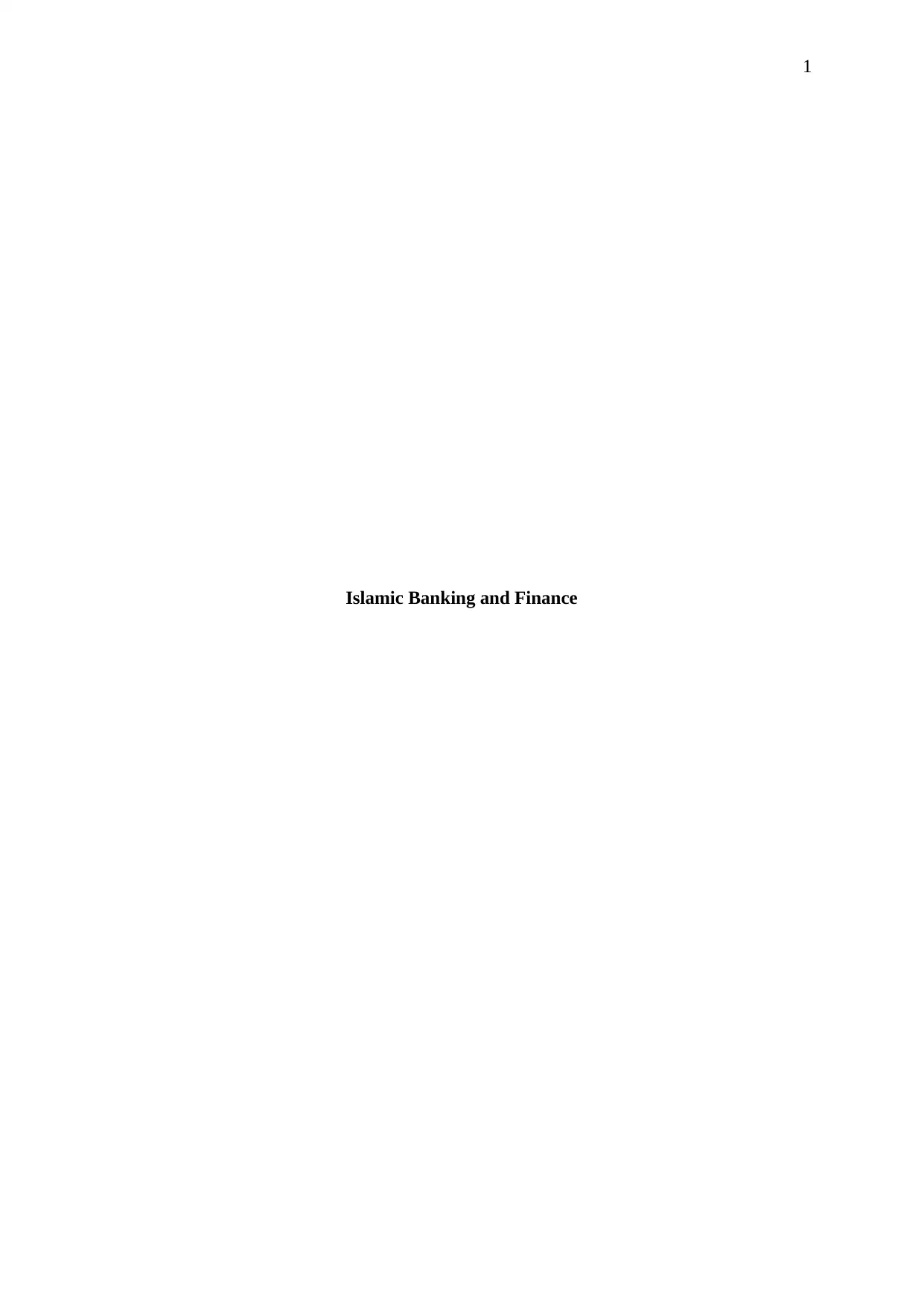
1
Islamic Banking and Finance
Islamic Banking and Finance
Paraphrase This Document
Need a fresh take? Get an instant paraphrase of this document with our AI Paraphraser
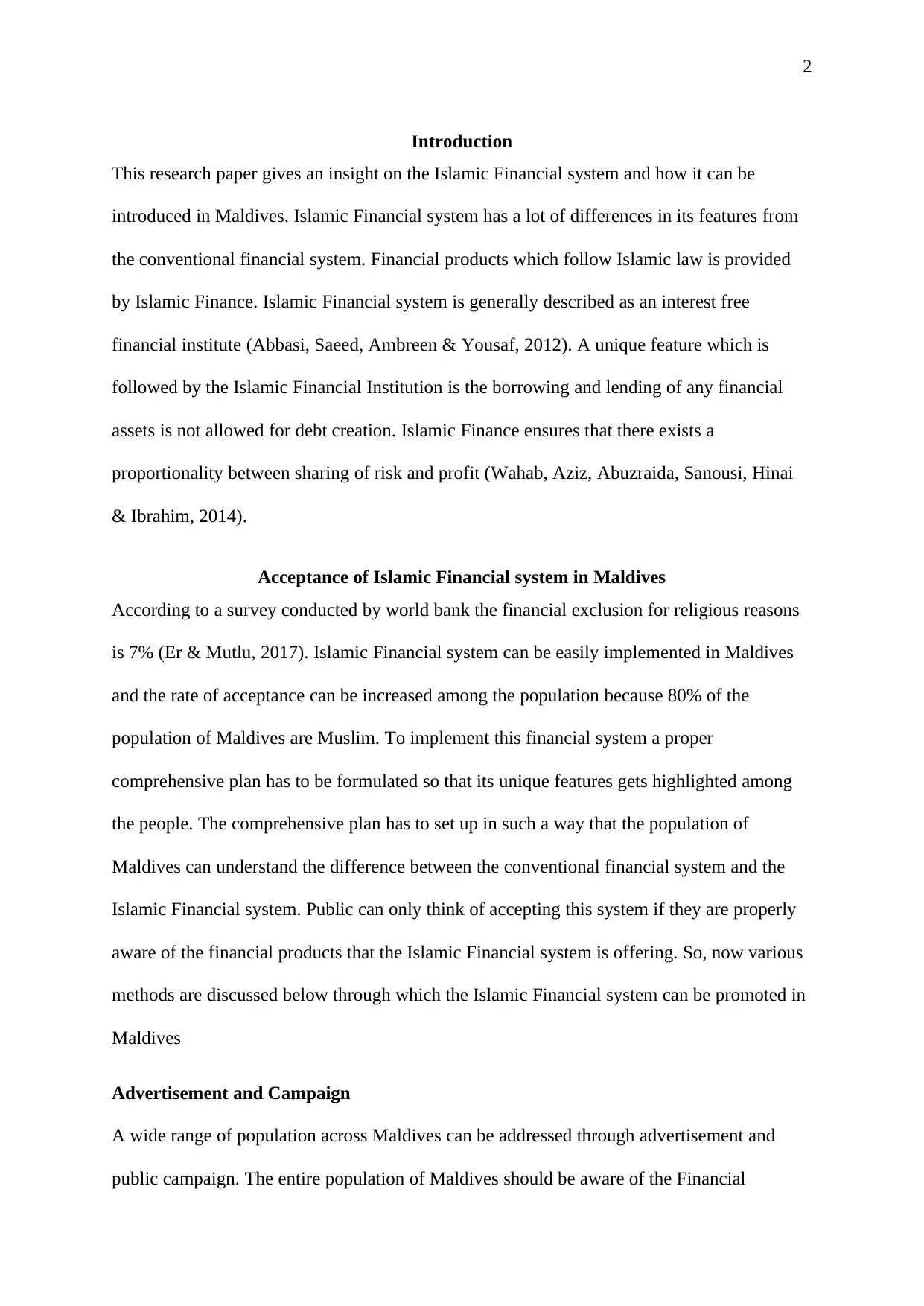
2
Introduction
This research paper gives an insight on the Islamic Financial system and how it can be
introduced in Maldives. Islamic Financial system has a lot of differences in its features from
the conventional financial system. Financial products which follow Islamic law is provided
by Islamic Finance. Islamic Financial system is generally described as an interest free
financial institute (Abbasi, Saeed, Ambreen & Yousaf, 2012). A unique feature which is
followed by the Islamic Financial Institution is the borrowing and lending of any financial
assets is not allowed for debt creation. Islamic Finance ensures that there exists a
proportionality between sharing of risk and profit (Wahab, Aziz, Abuzraida, Sanousi, Hinai
& Ibrahim, 2014).
Acceptance of Islamic Financial system in Maldives
According to a survey conducted by world bank the financial exclusion for religious reasons
is 7% (Er & Mutlu, 2017). Islamic Financial system can be easily implemented in Maldives
and the rate of acceptance can be increased among the population because 80% of the
population of Maldives are Muslim. To implement this financial system a proper
comprehensive plan has to be formulated so that its unique features gets highlighted among
the people. The comprehensive plan has to set up in such a way that the population of
Maldives can understand the difference between the conventional financial system and the
Islamic Financial system. Public can only think of accepting this system if they are properly
aware of the financial products that the Islamic Financial system is offering. So, now various
methods are discussed below through which the Islamic Financial system can be promoted in
Maldives
Advertisement and Campaign
A wide range of population across Maldives can be addressed through advertisement and
public campaign. The entire population of Maldives should be aware of the Financial
Introduction
This research paper gives an insight on the Islamic Financial system and how it can be
introduced in Maldives. Islamic Financial system has a lot of differences in its features from
the conventional financial system. Financial products which follow Islamic law is provided
by Islamic Finance. Islamic Financial system is generally described as an interest free
financial institute (Abbasi, Saeed, Ambreen & Yousaf, 2012). A unique feature which is
followed by the Islamic Financial Institution is the borrowing and lending of any financial
assets is not allowed for debt creation. Islamic Finance ensures that there exists a
proportionality between sharing of risk and profit (Wahab, Aziz, Abuzraida, Sanousi, Hinai
& Ibrahim, 2014).
Acceptance of Islamic Financial system in Maldives
According to a survey conducted by world bank the financial exclusion for religious reasons
is 7% (Er & Mutlu, 2017). Islamic Financial system can be easily implemented in Maldives
and the rate of acceptance can be increased among the population because 80% of the
population of Maldives are Muslim. To implement this financial system a proper
comprehensive plan has to be formulated so that its unique features gets highlighted among
the people. The comprehensive plan has to set up in such a way that the population of
Maldives can understand the difference between the conventional financial system and the
Islamic Financial system. Public can only think of accepting this system if they are properly
aware of the financial products that the Islamic Financial system is offering. So, now various
methods are discussed below through which the Islamic Financial system can be promoted in
Maldives
Advertisement and Campaign
A wide range of population across Maldives can be addressed through advertisement and
public campaign. The entire population of Maldives should be aware of the Financial
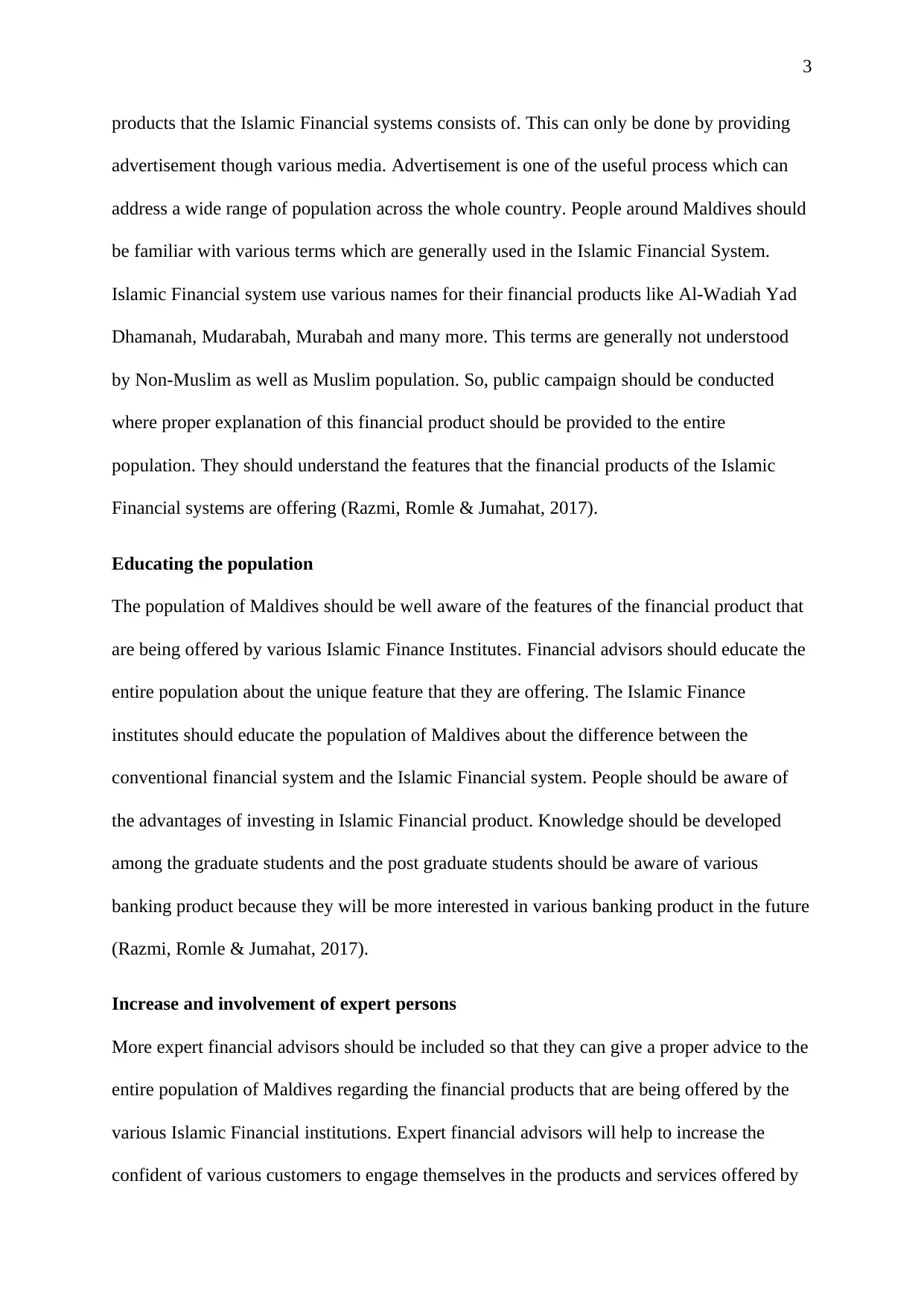
3
products that the Islamic Financial systems consists of. This can only be done by providing
advertisement though various media. Advertisement is one of the useful process which can
address a wide range of population across the whole country. People around Maldives should
be familiar with various terms which are generally used in the Islamic Financial System.
Islamic Financial system use various names for their financial products like Al-Wadiah Yad
Dhamanah, Mudarabah, Murabah and many more. This terms are generally not understood
by Non-Muslim as well as Muslim population. So, public campaign should be conducted
where proper explanation of this financial product should be provided to the entire
population. They should understand the features that the financial products of the Islamic
Financial systems are offering (Razmi, Romle & Jumahat, 2017).
Educating the population
The population of Maldives should be well aware of the features of the financial product that
are being offered by various Islamic Finance Institutes. Financial advisors should educate the
entire population about the unique feature that they are offering. The Islamic Finance
institutes should educate the population of Maldives about the difference between the
conventional financial system and the Islamic Financial system. People should be aware of
the advantages of investing in Islamic Financial product. Knowledge should be developed
among the graduate students and the post graduate students should be aware of various
banking product because they will be more interested in various banking product in the future
(Razmi, Romle & Jumahat, 2017).
Increase and involvement of expert persons
More expert financial advisors should be included so that they can give a proper advice to the
entire population of Maldives regarding the financial products that are being offered by the
various Islamic Financial institutions. Expert financial advisors will help to increase the
confident of various customers to engage themselves in the products and services offered by
products that the Islamic Financial systems consists of. This can only be done by providing
advertisement though various media. Advertisement is one of the useful process which can
address a wide range of population across the whole country. People around Maldives should
be familiar with various terms which are generally used in the Islamic Financial System.
Islamic Financial system use various names for their financial products like Al-Wadiah Yad
Dhamanah, Mudarabah, Murabah and many more. This terms are generally not understood
by Non-Muslim as well as Muslim population. So, public campaign should be conducted
where proper explanation of this financial product should be provided to the entire
population. They should understand the features that the financial products of the Islamic
Financial systems are offering (Razmi, Romle & Jumahat, 2017).
Educating the population
The population of Maldives should be well aware of the features of the financial product that
are being offered by various Islamic Finance Institutes. Financial advisors should educate the
entire population about the unique feature that they are offering. The Islamic Finance
institutes should educate the population of Maldives about the difference between the
conventional financial system and the Islamic Financial system. People should be aware of
the advantages of investing in Islamic Financial product. Knowledge should be developed
among the graduate students and the post graduate students should be aware of various
banking product because they will be more interested in various banking product in the future
(Razmi, Romle & Jumahat, 2017).
Increase and involvement of expert persons
More expert financial advisors should be included so that they can give a proper advice to the
entire population of Maldives regarding the financial products that are being offered by the
various Islamic Financial institutions. Expert financial advisors will help to increase the
confident of various customers to engage themselves in the products and services offered by
⊘ This is a preview!⊘
Do you want full access?
Subscribe today to unlock all pages.

Trusted by 1+ million students worldwide
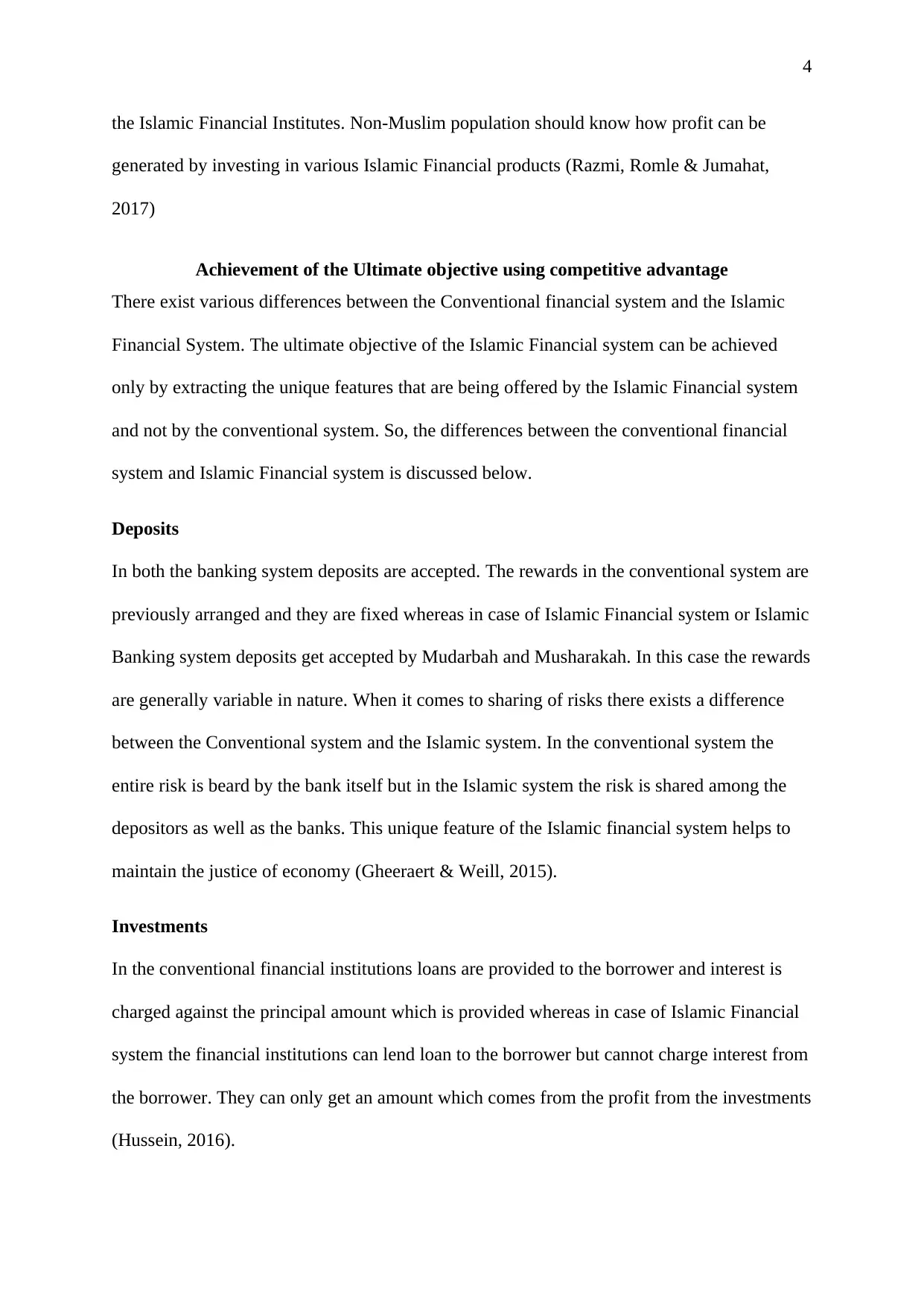
4
the Islamic Financial Institutes. Non-Muslim population should know how profit can be
generated by investing in various Islamic Financial products (Razmi, Romle & Jumahat,
2017)
Achievement of the Ultimate objective using competitive advantage
There exist various differences between the Conventional financial system and the Islamic
Financial System. The ultimate objective of the Islamic Financial system can be achieved
only by extracting the unique features that are being offered by the Islamic Financial system
and not by the conventional system. So, the differences between the conventional financial
system and Islamic Financial system is discussed below.
Deposits
In both the banking system deposits are accepted. The rewards in the conventional system are
previously arranged and they are fixed whereas in case of Islamic Financial system or Islamic
Banking system deposits get accepted by Mudarbah and Musharakah. In this case the rewards
are generally variable in nature. When it comes to sharing of risks there exists a difference
between the Conventional system and the Islamic system. In the conventional system the
entire risk is beard by the bank itself but in the Islamic system the risk is shared among the
depositors as well as the banks. This unique feature of the Islamic financial system helps to
maintain the justice of economy (Gheeraert & Weill, 2015).
Investments
In the conventional financial institutions loans are provided to the borrower and interest is
charged against the principal amount which is provided whereas in case of Islamic Financial
system the financial institutions can lend loan to the borrower but cannot charge interest from
the borrower. They can only get an amount which comes from the profit from the investments
(Hussein, 2016).
the Islamic Financial Institutes. Non-Muslim population should know how profit can be
generated by investing in various Islamic Financial products (Razmi, Romle & Jumahat,
2017)
Achievement of the Ultimate objective using competitive advantage
There exist various differences between the Conventional financial system and the Islamic
Financial System. The ultimate objective of the Islamic Financial system can be achieved
only by extracting the unique features that are being offered by the Islamic Financial system
and not by the conventional system. So, the differences between the conventional financial
system and Islamic Financial system is discussed below.
Deposits
In both the banking system deposits are accepted. The rewards in the conventional system are
previously arranged and they are fixed whereas in case of Islamic Financial system or Islamic
Banking system deposits get accepted by Mudarbah and Musharakah. In this case the rewards
are generally variable in nature. When it comes to sharing of risks there exists a difference
between the Conventional system and the Islamic system. In the conventional system the
entire risk is beard by the bank itself but in the Islamic system the risk is shared among the
depositors as well as the banks. This unique feature of the Islamic financial system helps to
maintain the justice of economy (Gheeraert & Weill, 2015).
Investments
In the conventional financial institutions loans are provided to the borrower and interest is
charged against the principal amount which is provided whereas in case of Islamic Financial
system the financial institutions can lend loan to the borrower but cannot charge interest from
the borrower. They can only get an amount which comes from the profit from the investments
(Hussein, 2016).
Paraphrase This Document
Need a fresh take? Get an instant paraphrase of this document with our AI Paraphraser
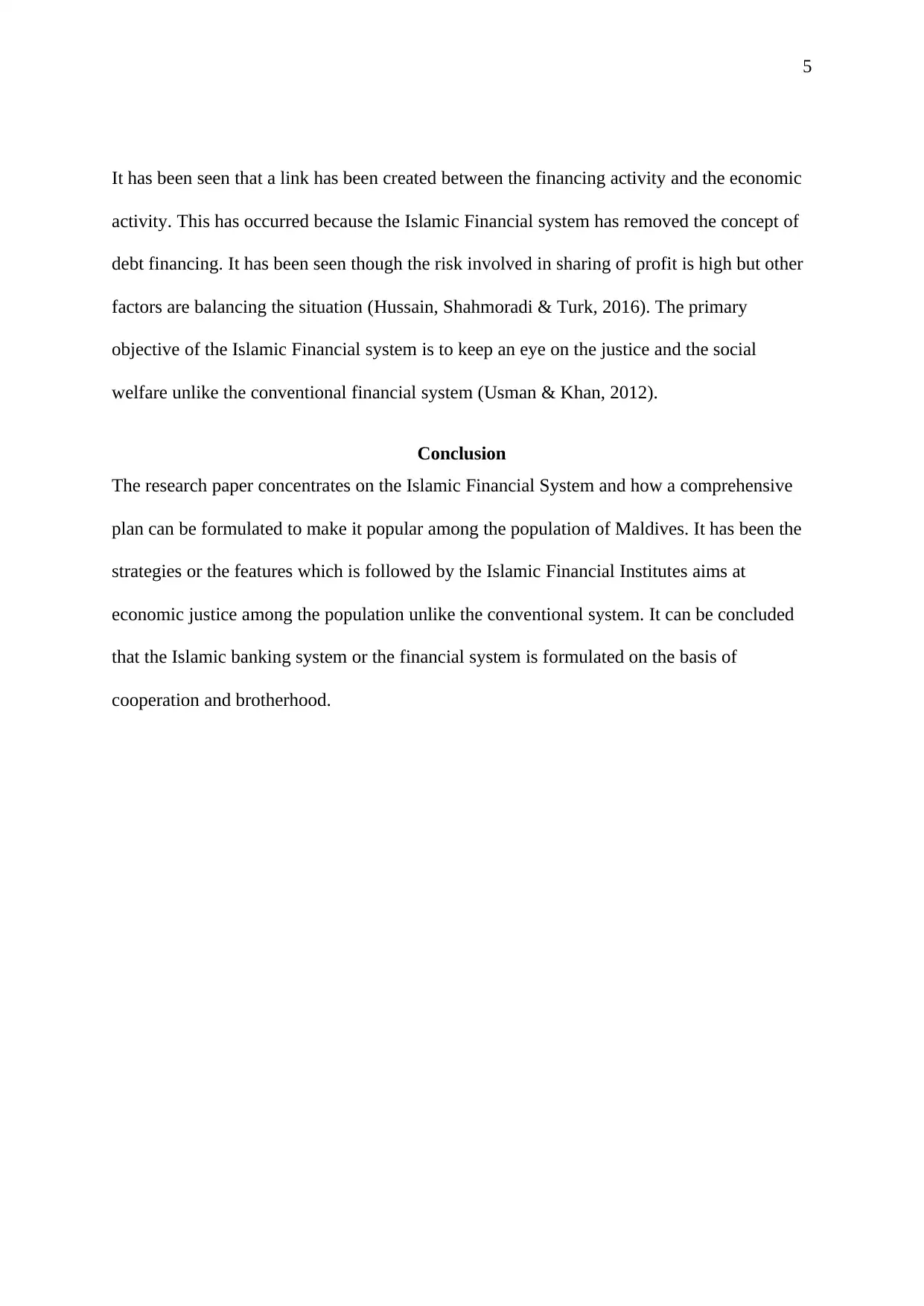
5
It has been seen that a link has been created between the financing activity and the economic
activity. This has occurred because the Islamic Financial system has removed the concept of
debt financing. It has been seen though the risk involved in sharing of profit is high but other
factors are balancing the situation (Hussain, Shahmoradi & Turk, 2016). The primary
objective of the Islamic Financial system is to keep an eye on the justice and the social
welfare unlike the conventional financial system (Usman & Khan, 2012).
Conclusion
The research paper concentrates on the Islamic Financial System and how a comprehensive
plan can be formulated to make it popular among the population of Maldives. It has been the
strategies or the features which is followed by the Islamic Financial Institutes aims at
economic justice among the population unlike the conventional system. It can be concluded
that the Islamic banking system or the financial system is formulated on the basis of
cooperation and brotherhood.
It has been seen that a link has been created between the financing activity and the economic
activity. This has occurred because the Islamic Financial system has removed the concept of
debt financing. It has been seen though the risk involved in sharing of profit is high but other
factors are balancing the situation (Hussain, Shahmoradi & Turk, 2016). The primary
objective of the Islamic Financial system is to keep an eye on the justice and the social
welfare unlike the conventional financial system (Usman & Khan, 2012).
Conclusion
The research paper concentrates on the Islamic Financial System and how a comprehensive
plan can be formulated to make it popular among the population of Maldives. It has been the
strategies or the features which is followed by the Islamic Financial Institutes aims at
economic justice among the population unlike the conventional system. It can be concluded
that the Islamic banking system or the financial system is formulated on the basis of
cooperation and brotherhood.

6
References
Abbasi, M. T. H., Saeed, M. N. R. M. K., Ambreen, A. A. G., & Yousaf, I. (2012). The
tendency of customers towards the acceptance of Islamic banking in Bahawalpur
region, Pakistan. Research Journal of Finance and Accounting, 3, 39-50.
Er, B., & Mutlu, M. (2017). Financial Inclusion and Islamic Finance: A Survey of Islamic
Financial Literacy Index. International Journal of Islamic Economics and Finance
Studies, 3(2), 23-34.
Gheeraert, L., & Weill, L. (2015). Does Islamic banking development favor macroeconomic
efficiency? Evidence on the Islamic finance-growth nexus. Economic modelling, 47,
32-39.
Hussain, M., Shahmoradi, A., & Turk, R. (2016). An overview of Islamic finance. Journal of
International Commerce, Economics and Policy, 7(01), 1650003.
Hussein, K. (2016). Bank-Level Stability Factors and Consumer Confidence—A Comparative
Study of Islamic and Conventional Banks’ Product Mix. Cham, United Kingdom:
Palgrave Macmillan.
Razimi, M.S.A., Romle, A.R., & Jumahat, J. (2017). The consumer acceptance on Islamic
Banking in Malaysia. World Journal of Management and Behavioral Studies, 5(1),
14-20.
Usman, A., & Khan, M. K. (2012). Evaluating the financial performance of Islamic and
conventional banks of Pakistan: A comparative analysis. International Journal of
Business and Social Science, 3(7). .25-36
Wahab, A. A. O. A., Aziz, M. R. A., Abuzraida, O. A., Al Sanousi, A. M., Al Hinai, A. R. H.,
& Ibrahim, A. (2014). A comparative study of Islamic financial system and
References
Abbasi, M. T. H., Saeed, M. N. R. M. K., Ambreen, A. A. G., & Yousaf, I. (2012). The
tendency of customers towards the acceptance of Islamic banking in Bahawalpur
region, Pakistan. Research Journal of Finance and Accounting, 3, 39-50.
Er, B., & Mutlu, M. (2017). Financial Inclusion and Islamic Finance: A Survey of Islamic
Financial Literacy Index. International Journal of Islamic Economics and Finance
Studies, 3(2), 23-34.
Gheeraert, L., & Weill, L. (2015). Does Islamic banking development favor macroeconomic
efficiency? Evidence on the Islamic finance-growth nexus. Economic modelling, 47,
32-39.
Hussain, M., Shahmoradi, A., & Turk, R. (2016). An overview of Islamic finance. Journal of
International Commerce, Economics and Policy, 7(01), 1650003.
Hussein, K. (2016). Bank-Level Stability Factors and Consumer Confidence—A Comparative
Study of Islamic and Conventional Banks’ Product Mix. Cham, United Kingdom:
Palgrave Macmillan.
Razimi, M.S.A., Romle, A.R., & Jumahat, J. (2017). The consumer acceptance on Islamic
Banking in Malaysia. World Journal of Management and Behavioral Studies, 5(1),
14-20.
Usman, A., & Khan, M. K. (2012). Evaluating the financial performance of Islamic and
conventional banks of Pakistan: A comparative analysis. International Journal of
Business and Social Science, 3(7). .25-36
Wahab, A. A. O. A., Aziz, M. R. A., Abuzraida, O. A., Al Sanousi, A. M., Al Hinai, A. R. H.,
& Ibrahim, A. (2014). A comparative study of Islamic financial system and
⊘ This is a preview!⊘
Do you want full access?
Subscribe today to unlock all pages.

Trusted by 1+ million students worldwide
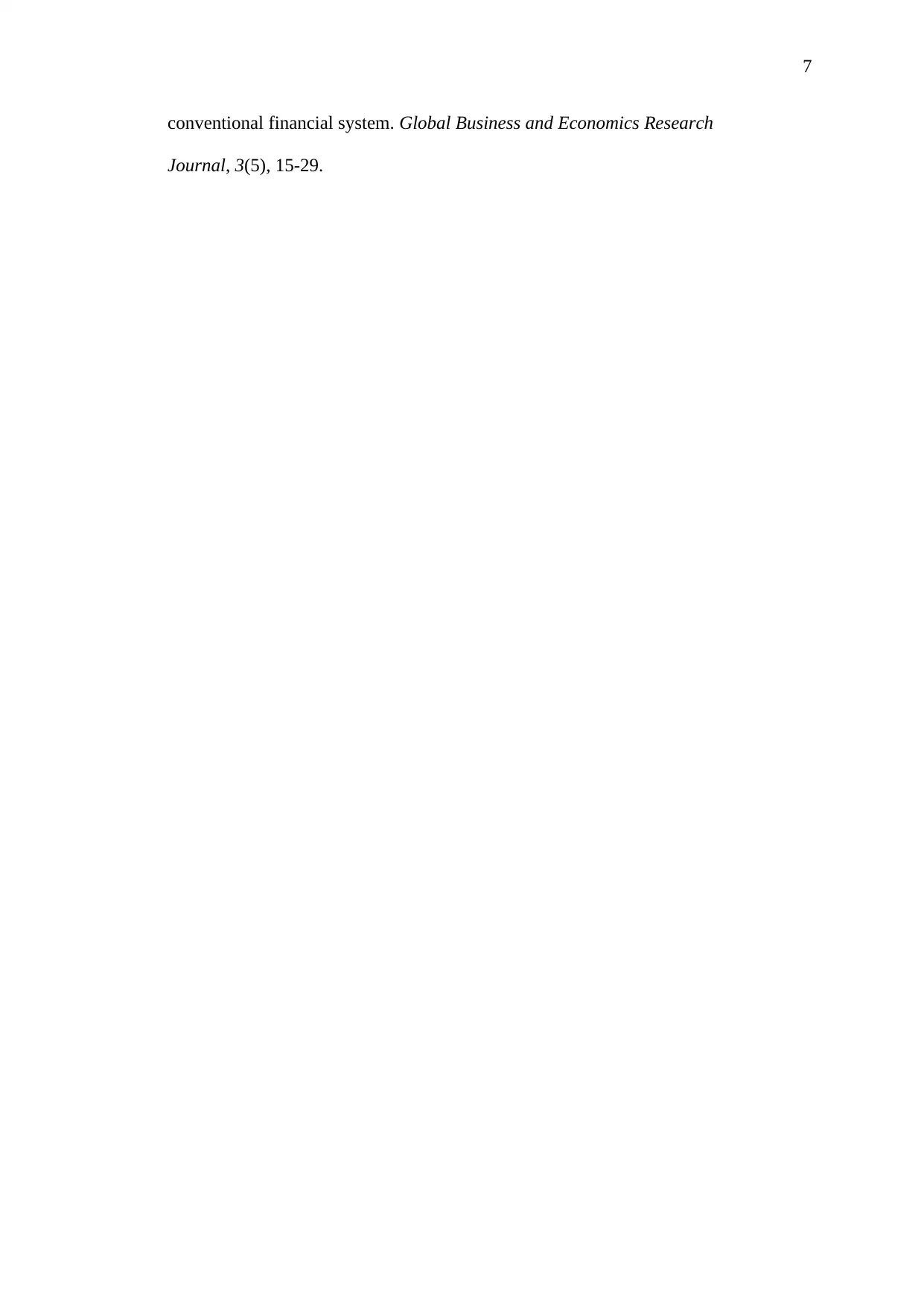
7
conventional financial system. Global Business and Economics Research
Journal, 3(5), 15-29.
conventional financial system. Global Business and Economics Research
Journal, 3(5), 15-29.
1 out of 7
Related Documents
Your All-in-One AI-Powered Toolkit for Academic Success.
+13062052269
info@desklib.com
Available 24*7 on WhatsApp / Email
![[object Object]](/_next/static/media/star-bottom.7253800d.svg)
Unlock your academic potential
Copyright © 2020–2025 A2Z Services. All Rights Reserved. Developed and managed by ZUCOL.





